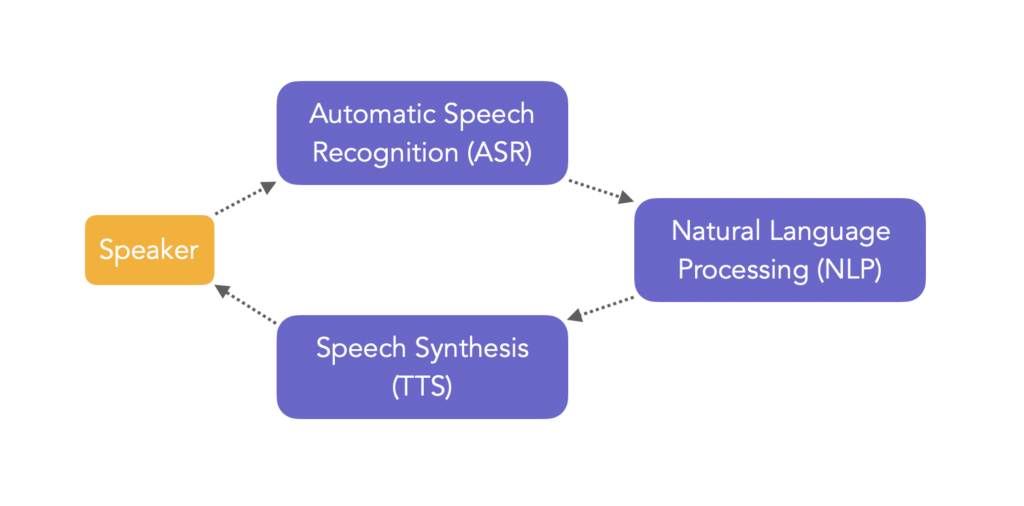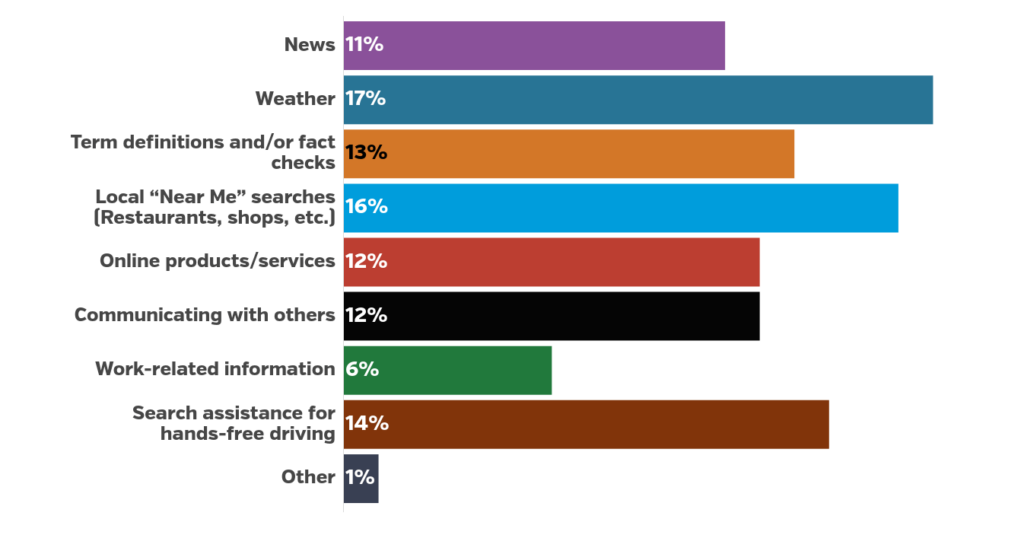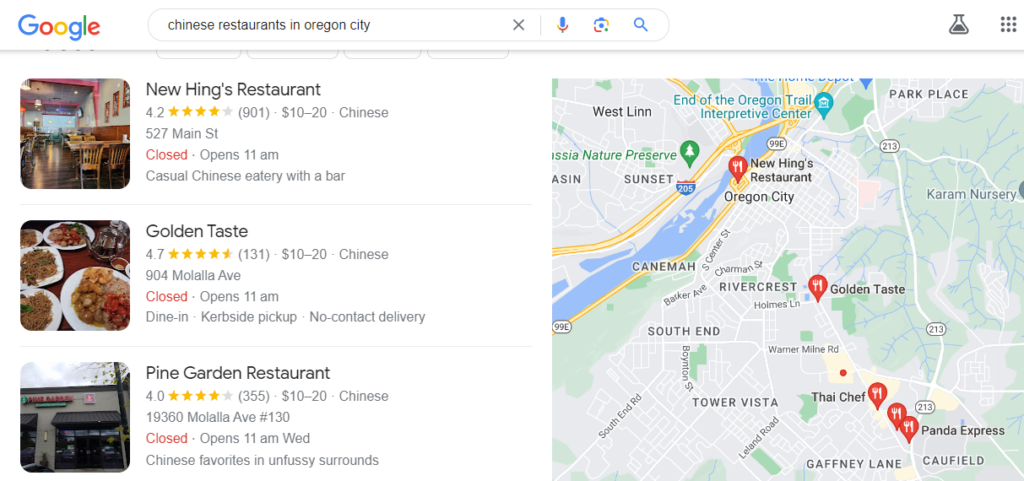There were more than 125.2 million voice search users worldwide at the end of 2023, and these users generated more than a billion voice searches per month. If your website isn’t optimized for voice search, you are losing a lot of customers.
Voice search impacts SEO in multiple ways. It is reshaping the way people use search engines.
This article explores the impact of voice search on SEO and how businesses can capitalize on it by making their sites and content voice-ready.
What is Voice Search?
When a person searches for something through a voice command on a search engine or smart device, it is known as a voice search. Instead of typing a search query, the user has to verbally ask a question to get results.
The search result in the case of voice search, could either be:
- a direct answer to the query
- the user is directed to a specific URL
- the user gets a complete list of search results in text form.
The output depends on the device used for voice search and the type of query.
Speech search is more common on mobile devices and smart devices. It can also be used on computers via search engines like Google and Bing. Users can input search queries through voice by clicking the microphone option in the search bar:

Users can access voice search in different ways across multiple devices including:
- Search engines across all devices
- Voice assistants like Siri and Google Assistant
- Smart devices like Alexa.
How Voice Search Works?
Voice search uses automatic speech recognition (ASR), natural language processing (NLP), and speech synthesis to convert spoken words into text. When a user asks a question, it is converted into text, and then results are found as they are for any text-based search query.
The text-based results are then returned to the user either in the form of written or speech form. When the text is converted back to speech, it involves speech synthesis which is a type of artificial intelligence that produces human speech:

The complete process is quite complex and isn’t as straightforward as it seems. It uses machine learning and artificial intelligence (AI) to better understand and generate speech.
The important thing to note, as a marketer, is that voice uses text-based search. The search algorithm principles remain the same for speech search as it is converted into text and uses the same search engine database, indexing, and ranking.
Voice Search Vs. Text Search
Voice and text search have quite a few differences but they both work in the same way. Here’s a list of the major differences between the two:
- Voice search queries are conversational and detailed as opposed to text-based queries. People ask direct and detailed questions to get answers when they use a voice assistant which isn’t normal for text-base queries.
- Local search queries are dominated by voice search as most people use voice to find nearby places via their smartphone when they can’t type. Text-based queries aren’t skewed towards one specific type.
- Voice search is quicker than text search. Research shows that 43% of people use voice search because it’s quicker and they can use it while driving with ease. Text search doesn’t offer this comfort, unfortunately.
Despite differences, the backend mechanism of both voice and text search is the same and the results users get are almost similar.
Does this mean there isn’t anything like voice search SEO?
Not really…
Impact of Voice Search on SEO
Speech search is an advanced version of text search which means marketers and businesses have to figure out how they need to optimize their content and sites for voice.
Voice search impacts SEO in multiple ways as discussed below:
1. Change in search behavior
Speech search has significantly changed user behavior. The way people interact with search engines has undergone major changes in the past few years.
The number of voice assistants has increased significantly, a switch to smart devices and smart homes, an increasing number of digital voice assistants, and widespread use of mobile devices are the major changes that persuaded people to use more voice search and rely heavily on it.
These changes have transformed search behavior in the following ways:
- Conversational and longer search queries
- Expectation to get an instant, concise reply to the search query
- More people prefer using voice search over text search
- Use voice to type text messages, shop online, and contact customer support via voice assistant.
A study reported that 71% of people prefer voice search over text and rely heavily on voice assistants to do daily tasks:

As much as 50% of people use voice assistants to shop online and another 25% say that they’ll use voice assistants to buy products online in the future:

A Google study reported that 72% of people use voice-activated speakers as part of their daily routine:

The way people interact with their devices will continue to change in the coming years. Voice search might turn out to be the preferred way to search and shop online.
2. Conversational queries
Speech search leads to more conversational queries.
A conversational query involves natural phrases and sentences. It is more like how people talk. Here’s an example of a conversational query:
“What is the best way for a female to lose belly fat?”
People tend to speak naturally when they are communicating with a voice assistant or smart device. This changes the type of search queries from short keywords to long conversational, complete sentences.

This impacts SEO in two ways:
- You have to focus on creating more in-depth content that targets and covers the topic in depth. Marketers have to explicitly target conversational keywords either in the form of FAQs or headings.
- Users expect to have direct, concise answers to their queries naturally. That’s what most voice-enabled devices do. They don’t send a list of top search results, rather they verbally communicate the answer to the query in a few short sentences.
Here’s how you can effectively improve conversational search for your content:
- Use natural language in content. Use words that people use.
- Add a FAQs section
- Target user intent instead of keywords because conversational search is entirely based on intent
- Cover all the aspects of the topic in detail.
3. Long-tail keywords
One major outcome of conversational search is long-tail keywords.
Speech searches have 7+ words on average as compared to text searches that usually have 1-3 words:

The reason is that speech searches are conversational (as discussed above) and usually have a higher word count. This calls for a major shift in SEO and keyword research as it requires businesses to target long-tail keywords for voice search optimization.
Targeting long-tail keywords has three major SEO benefits:
- They are easy to rank
- They have a high conversion rate as compared to short-tail keywords
- Long-tail keywords are more likely to be picked up as featured snippets (more on this later in the article).

You need to target long-tail keywords smarty as Google doesn’t like to see all long-tail keywords on your blog as it seems to be ‘search manipulation’. Try to keep it normal and mix long-tail, short-tail, and conversational keywords to optimize your site for voice.
4. More local searches
More than half of the voice searches are to find local businesses with ‘weather’ and ‘near me’ queries. Search assistance during driving is the third most common speech search usage:

Local searches are driven by local SEO and that’s how voice search is impacting your SEO strategy. If you haven’t optimized your website for local searches, you are losing potential customers.
Keep reading to find out how to improve the local SEO of your website.
5. Increased voice purchases
Speech search isn’t just used for information purposes. People use it to make online purchases.
One in three people use voice to discover new information about products and services while ordering new products via voice is the top priority of 54% of US consumers, and 65% of people say that tracking a package and checking the delivery status of a parcel are the two most important tasks they use voice for:

Consumers don’t purchase all types of products through voice. For example, buying a t-shirt through speech might be problematic as it requires checking the size, fabric, and other details. Products that a user is already familiar with or repeat purchases are more likely to be ordered via voice.
The top 3 categories of purchases made through smart speakers include:
- Health and beauty
- Electronics
- Household supplies.

It is a massive opportunity for ecommerce stores. You need to add a voice shopping option to your store and make it accessible so it can be accessed by all types of devices and people irrespective of how they visit your store.
6. Mobile optimization
The need for mobile optimization has increased in the past few years. A mobile-optimized site is essential for voice optimization.
Why?
The majority of people use voice search through their smartphones. Google Assistant and Siri are the two most used voice-enabled services people use:

Most of these people will eventually visit your website to find more information and that’s where a well-optimized and mobile-friendly site comes into play.
If your site isn’t responsive, it won’t rank high in voice SERPs. It is essential to optimize your site for mobile devices and ensure your site scores well on core web vitals metrics.
7. Refined user intent
User intent or search intent is the purpose behind a search query. With voice search, the intent is more refined and clearer. This is because these queries are conversational and long-tail which simplifies user intent.
Here’s an example of a voice search query:
Where can I buy Dove soap with free shipping in Vegas?
The search intent is transactional and indicates that the user is interested in buying Dove soaps in Vegas.
These types of search queries make targeting easier for businesses. You can create and optimize content around different types of intent that align with different stages of the sales funnel:

Targeting search intent in content makes it easy for search engine crawlers to understand, index, and rank your site for appropriate voice searches.
8. More focus on schema markup
Structured data plays a major role in voice search as it helps search engines better understand the context and content of your site.
For example, star rating, price, free shipping, product images, etc. are all different types of data that you can add to your web pages to improve voice ranking.
If you have added pricing and shipping cost to your products, you have a better chance to rank for voice queries that ask for price and/or shipping costs. Search engines can quickly find the sites that show relevant details through structured data as entire page crawling isn’t needed.
You can use this free tool by Google to test structured data.
Voice Search Optimization Best Practices
Here’s a list of the proven techniques and tactics to improve your site’s speech search:
1. Improve keyword targeting
Voice search focuses on conversational and long-tail keywords and this should be your primary goal during the keyword research process.
The three major types of keywords you need for voice search include:
- Long-tail
- Conversational
- Questions.
You can use a free keyword research tool like Google Keyword Planner or a paid SEO tool like Ahrefs. These tools will do a decent job of creating a list of long-tail keywords around a broad topic but you don’t have to just stick with these tools.
Keyword research for speech queries should involve manual research. You need to manually analyze all of the following to find new keywords and refine existing ones:
- SERP analysis: It helps you understand search intent for queries (more on this below). It involves analyzing top-ranking pages and figuring out what long-tail keywords they are ranking for with traffic estimates per keyword. You’ll need an SEO tool to analyze results individually.
- People also ask: Google shows you relevant questions that people ask with short answers for each one. This is the best place to find conversational question keywords as they are what users are more likely to use during voice search. You can check related queries for each question through a keyword research tool that helps you generate several long-tail keywords.
- Related searches: Google, Bing, and other search engines show you related searches for any keyword you enter. This is a nice way to find out relevant queries including long-tail ones. Don’t miss these.
- Featured snippets: The short snippets of text that provide the answer to the query at the top are a goldmine. This is the text that’s used by voice assistants and speakers the most. Use it to find the type of queries and intent it addresses.
- Rich snippets: The markup data you see in search results for a query indicates the search intent and helps you identify relevant keywords to target.
Keyword research for voice shouldn’t ignore intent. Make sure you have the search intent updated in the keyword list:

Refer to the top search results and Featured Snippets in Google to find the intent because top-ranking pages are the ones Google algorithm has identified as the best sources that meet searcher expectations.
Then align search intent to your sales funnel to ensure the right people get the right information over voice search:

You don’t have to experiment with the intent. Do what’s already working.
2. Target featured snippet
Research shows that 41% of voice search answers are picked from the featured snippet. Aiming for the featured snippets is the easiest way to boost voice SEO.

On average, a featured snippet has 29 words. This means the answer has to be short and crisp. Importantly, most voice answers cite or direct visitors to the source.
There isn’t any guaranteed way to reach the featured snippet. Google chooses the best possible answer from the top 3 or often top 10 ranking pages. So, you need to make sure your content is good enough to reach the first page. If you aren’t ranking on the first page, Google is least likely to use your content in featured snippets and consequently, voice search.
Google keeps changing featured snippets which is a good thing. It means you can outperform an existing snippet with better content.
Here are the best practices to optimize content for featured snippets:
- Use simple language
- Address the query or topic concisely in under 30 words
- Your content needs to be factually accurate
- Use facts, citations, and images to make your content better
- Use the appropriate search intent
- Avoid being unorthodox. Google’s algorithm relies on consensus which means you need to explain, expand, or add more value to the already-established facts. If you are coming up with something new (that’s against facts), you won’t make it to the featured snippet.
3. Improve content
Keyword research isn’t enough to optimize your website for voice search. You need to update and tweak content for speech. The new content you create should follow a systematic process so it ranks high in voice SERPs.
You need to improve existing content and create new content based on the following tactics to ensure its visibility and ranking for speech queries:
- Write in-depth content that covers the entire topic. This is critical because covering the topic or target keyword completely enhances your chances of addressing all major and even minor queries that readers might have and this is exactly what voice search is all about.
- Distribute content into headings, subheadings, bullets, and different sections where each section discusses a unique sub-topic. This makes it easy for crawlers to understand content and they are more likely to find the right answer quickly.
- Use natural language. Avoid jargon, technical terms, and complex language. Keep sentences short and write them as if you are talking directly to the readers.
- Start a new section, heading, or sub-heading by writing a short 1-2 sentence explanation of what this section is about. And then go into details. This increases your content’s probability of being featured in Featured Snippets and People also ask.
- Stick with the search intent. If existing content has informational intent, you need to stick with the same. Don’t experiment or you won’t be able to make it to the first page ever.
- Use keywords naturally. Avoid stuffing keywords unnecessarily. Search engines use latent semantic indexing to find patterns which means you can rank for keywords that you haven’t mentioned in the content.
- Use Search Generative Experience (SGE) that is now part of Google and Bing search. The quick AI-generated answer to the query at the top shows what type of content is expected. It also shows you the content format, types of media to use, and other key information. Look at the citations from SGE to get ideas. You don’t have to replicate AI content but use it to create voice-optimized content.
- Add FAQs section in your content. Google only displays FAQs schema for health and government websites as announced in 2023 here. This doesn’t mean you should avoid using it. You need to add a FAQs list (not necessarily schema) to increase voice search visibility.
- Use rich snippets like reviews, prices, images, etc. Align structured data with target keywords and search intent. For example, adding price data might not be a good idea for informational intent queries.
You can easily address and maintain these content writing and optimizing guidelines with a brand style guide that clearly defines typography, writing guidelines, formatting details, color scheme, and much more. Here’s an example of a brand style guide:

Share your content style guide with writers, editors, and marketers so that you don’t have to tweak and optimize content at a granular level.
4. Focus on local SEO
It is the process of optimizing your site for location-based search queries. The majority of the voice search queries are localized. A study found that 58% of voice search queries are related to local businesses. Search engines have to use data from search directories to furnish such requests
Google Business Profile, for example, is a directory for local businesses by Google where you can list your business with all its details. It then shows in Google local search and Google Maps.
Here’s an example of a local search query results:

These results are pulled from Google Business Profile data. Businesses that don’t have their profiles won’t make it to this list.
You need to list your local business in directories like Yelp, Bing Places, Yellow Pages, and others.
The listing needs to be optimized for local search queries. Find local keywords relevant to your business and target them to make sure your site ranks for the right local keywords.
The Future is Voice Search
We are gradually moving away from traditional text-based search. It won’t go away completely, but most of it will be replaced by other forms of search such as voice, image, and others.
Google is already offering mobile voice search in 119 languages and still growing. As more smartphone users will have access to their local languages, we’ll see an increase in the number of people who use speech search.
Couple this with a shift towards smart devices and smart homes operated over voice, the shift is inevitable. Alexa, for example, is available on more than 100 million devices globally.
Voice optimization is a must for your business. If you have a search-friendly site that is fully optimized, a few minor tweaks will make it voice-ready. This will give you access to a whole new world where you can reach, connect, and interact with a new audience.
Get started today.
Featured Image: Pexels



